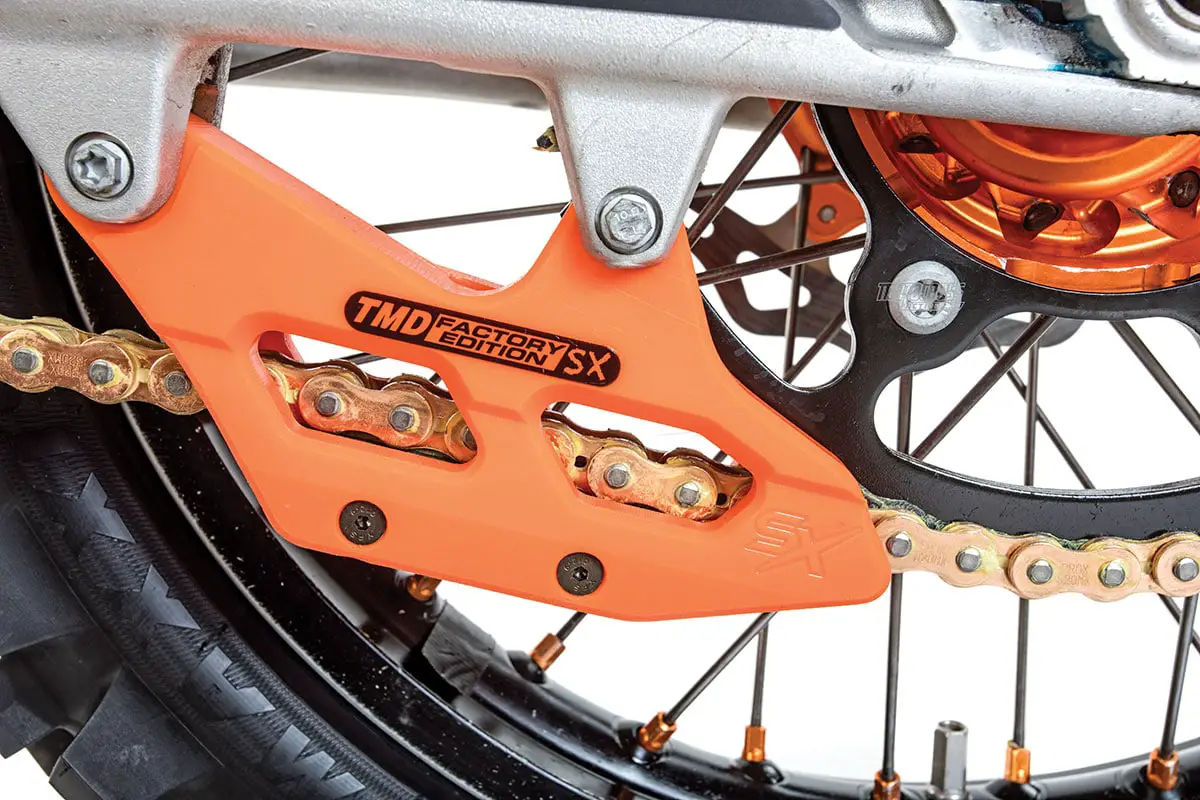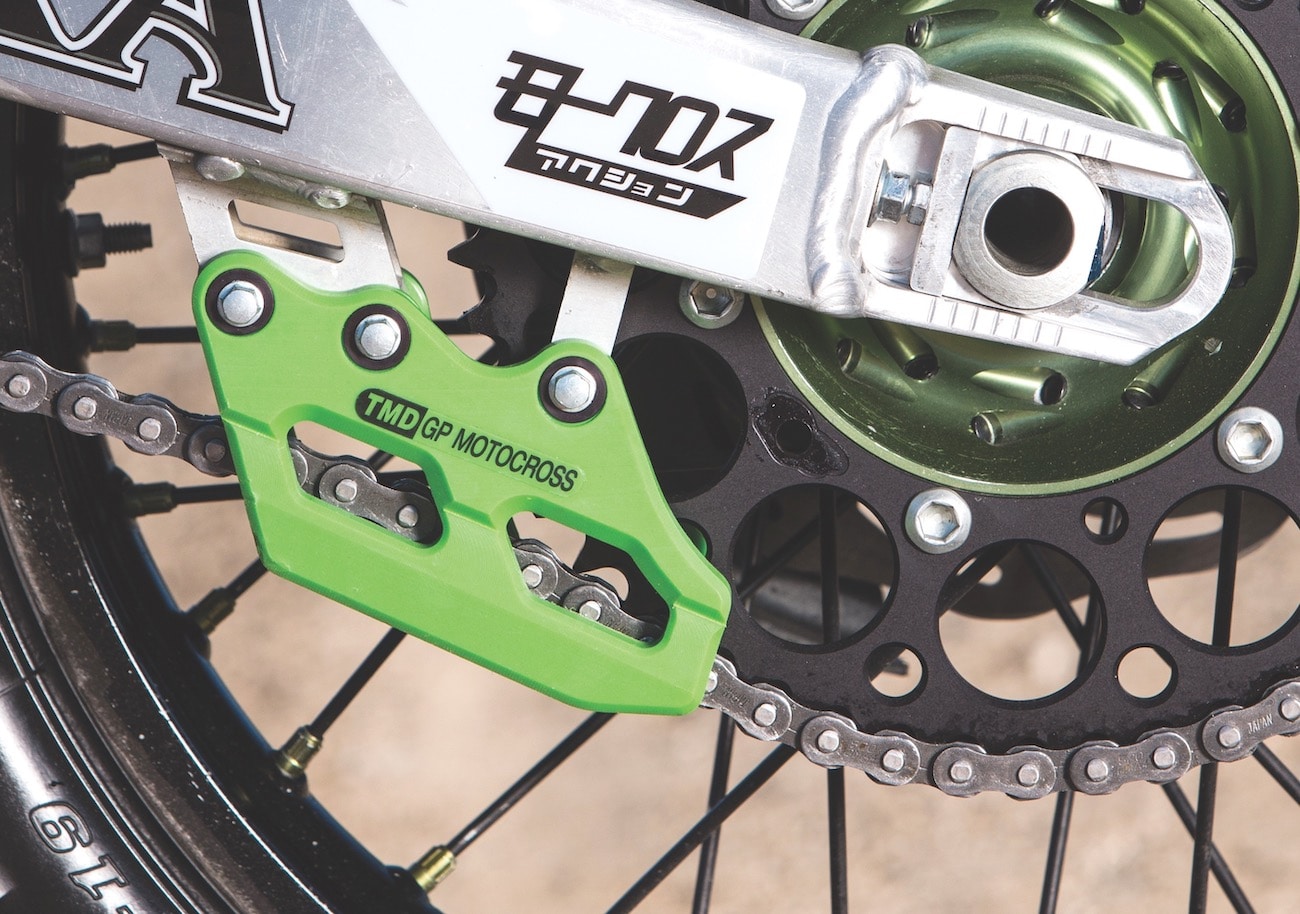TEN THINGS ABOUT CHAIN GUIDES, SLIDES, BUFFERS AND ROLLERS
(1) Chain guides. If you’ve ever ridden a single-speed bicycle with a loose chain on a bumpy surface, you know that the chain will bounce around and make noise until it finally derails. In that case, you would have to tighten the chain to fix the issue. On motorcycles, a chain guide is used to feed the chain onto the rear sprocket. If the chain were allowed to float back, without the lift and direction that the chain guide provides, it would be susceptible to bouncing itself out of line and lodging itself between the chain and the rear sprocket.
(2) Chain sliders. Chain sliders are used to feed the chain onto the countershaft sprocket. They also work to reduce chain noise, as well as to protect the aluminum swingarm from damage. Without the front buffer slider, the chain would smack the swingarm, causing excessive noise and damage.
(3) Chain rollers. To protect the frame’s bottom cross-braces from the chain, Japanese-model dirt bikes use round chain rollers. Without the roller, the chain would rub against the frame. These rollers often have bearings inside that can easily wear out and begin to wobble. If you own a Honda, Suzuki, Kawasaki or Yamaha, be careful when pressure-washing near your chain roller. Water is not friendly to chain-roller bearings.
(4) Frame pads. KTM and its sister brands Husqvarna and GasGas choose to use an enlarged frame pad instead of a roller. The pad accomplishes the same objective of ensuring the chain doesn’t drag on the cross member of the frame, but it does this without any moving parts. Comparatively, the pad is cheaper to make and less likely to break. Although there’s potentially more drag with a frame pad, it increases durability.
(5) Chain slack. Running a chain with excess slack creates more noise and more drag while it also damages the chain, sprockets, chain slider and chain guide. A loose chain accelerates the rate at which the guide and slide wear out. This diminishes their ability to control the chain as it is being sent onto the sprockets and leaves more room for debris to get stuck in between the chain and sprockets. The quality of your chain works hand-in-hand with slack, as more durable chains maintain their length for a longer period of time. Each manufacturer provides a maximum stretch range that you should keep your chain length within. If is gets too long, this means that the rollers and pins have worn out. Time to get a new chain.
(6) Chain drag. Less friction equals more efficient performance. High-tech performance companies polish engine components and coat suspension components with diamond-like coatings (DLC) or Kashima coatings to lessen friction. Similarly, aftermarket chain guide and slide manufacturers work to lessen chain drag by using unique plastic formulas on their products. TM Designworks uses oil impregnation and UV protectant to reduce drag. The UV protectant also works to prevent the plastic from cracking and fading.
(7) Stock guides. Japanese brands like Kawasaki, Yamaha, Honda and Suzuki use an aluminum outer shell with a replaceable rub block inside of their chain guides. The Austrian brands—KTM and Husqvarna—use an aluminum plate molded inside of a plastic guide. Because of the aluminum plate, the KTM and Husky guides are stronger than those of their competitors, but when they wear out, the entire piece has to be replaced, whereas owners of Japanese bikes can replace their OEM rub blocks.
(8) Aftermarket kits. The number-one reason to invest in an aftermarket chain guide and slide kit is to protect your chain from derailing and increase its durability. TM Designworks’ return memory plastic allows its guides to absorb impacts and bend back into their original position afterwards. Similarly, Zeta Racing has designed a unique fin on the bottom of its guides to reduce the amount of contact between the guide and the ground which lessens the effects of impacts.
(9) Case savers. The term “case saver” is a misnomer. The metal bracket in front of the countershaft sprocket is no guarantee that your cases will not be cracked by the impact of a broken chain at full throttle. What it will do is act as a buffer for a loose chain that swells outward as it makes the tight circle around the countershaft sprocket. For a case saver to actually save a case, it would have to be frame-mounted at each end instead of bolted to the cases. Plastic case savers can be better than steel or aluminum ones, but the best defense is a quality chain that is adjusted to the amount of slack in your brand’s owner’s manual.
(10) Countershaft covers. Countershaft sprocket covers prevent unwanted body parts or debris from being lodged between the sprocket, chain and engine cases in a crash. All OEM motocross bikes have some type of countershaft cover (play bikes and kids’ bikes have much larger countershaft covers). Under AMA rules, countershaft covers are optional, but FIM rules state they are mandatory in Grand Prix races.








Comments are closed.